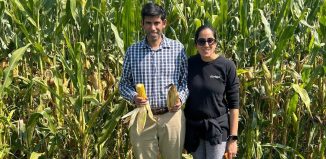BNL’s Newton ponders movement of energy
Like a philosopher, Marshall Newton ponders the journey and the destination. Except that what he’s pondering often has to do with the movement of energy rather than the circuitous path through life.
A professor emeritus of chemistry at Brookhaven National Laboratory, Newton retired on January 1, 2009, but, by several accounts, that hasn’t slowed him down. He said retiring freed him up from the “important but time-consuming departmental and lab-wide committee meetings,” enabling him to “get back in depth to some scientific issues which I never had time to fully pursue in the past,” he explained.
Newton tries to understand how energy moves from one place — often at the start of photosynthesis — to a form of energy stored or used in another place. “What I do,” he explained, “is formulate mechanisms for a key process that typically occurs in almost all energy conversion processes.”
Theorists like Newton want to assess the possible pathways “for the efficient capture and conversion of energy.” Part of this conversion involves electronic transfer, which is usually coupled to heavy atoms that must go over a hill or energy barrier as part of the overall transfer process. That process represents something of an energy cost, the way a local diner might incur costs paying for electricity or gas.
Newton develops quantum mechanical models to analyze the efficiency of such processes. He has investigated molecular processes that may serve as components of new artificial photosynthesis schemes, either photochemical or electrochemical.
In artificial photosynthesis, researchers try to mimic the energy generated by plants from carbon dioxide, water and the sun.
Newton is “recognized worldwide for his scientific contributions combining his knowledge of electronic structure, electrochemistry and a wide range of other chemistry,” said James Muckerman, a senior chemist at BNL who has known Newton for close to half a century.
Newton, who started working at BNL in 1969, said that chemists used to be “in the dark ages” about calculating what happened on an incredibly small time scale. Theory and experiment have “bootstrapped” each other in achieving finer and finer distance and time scale, he said.
The benefit of all the theoretical work with computer simulations and models is that it can help guide future design ideas for solar cells or other energy capturing and transferring processes.
Theorists can “turn over [their results] to engineers and say, ‘This is what you should do to make optimal energy material,’” Newton offered. That, he added, is easier said than done.
When scientists try to move energy or charge, the standard problem is the dissipation or loss of that energy along the way. It’s akin to carrying a bag of groceries home from the store and bumping into walls along the way. Each time you bumped into a wall, you’d lose something from your bags. Specifically, relatively high-electronic energy from photons runs the danger of being degraded to heat and transferring charge or excitations can get trapped by “defects.”
Newton said retirement has given him more freedom to indulge his intellectual obsessions, including theoretical chemistry and other fields — both scientific and non-scientific. He hasn’t had any urge to take refuge in fishing or golf.
“The beauty of today’s life is that retirement is whatever you want to make of it,” he said. “It’s much more common now to be active retired. For the last five years, I’m doing more or less than the same things as the first 40, due to the generosity of my department and my department head, Alex Harris.”
Raised in Boston, Newton, who prides himself on not having a regional accent, lives in Strongs Neck with his wife Natika, a philosopher who until last year was also a professor at Nassau Community College. In the fall, she will teach a course in the Osher Lifelong Learning Institute at Stony Brook.
His daughter, Erika Newton, is a staff physician at the Stony Brook Medical Center. Her husband, John Hover, is leader of the grid group at BNL, which is part of the Relativistic Heavy Ion Collider ATLAS computing facility.
Son Joel, who lives in Nyack, New York, is a guitarist who plays jazz and fusion with the Joel Newton Situation. The benefit of the collaboration between theoretical and applied chemistry becomes clearer over time.
“The interplay of theory and experiment is grist for historians and philosophers of science,” Newton said.






